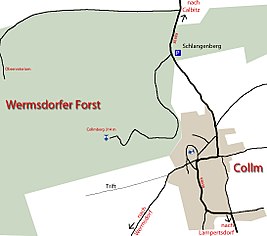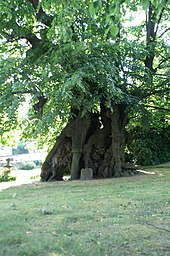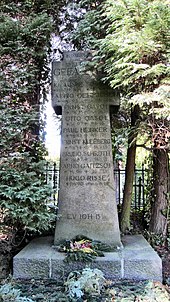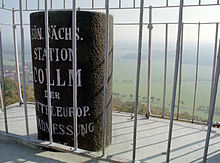Collm
|
Collm
Wermsdorf municipality
Coordinates: 51 ° 18 ′ 5 ″ N , 13 ° 1 ′ 15 ″ E
|
|
|---|---|
| Height : | 220 m above sea level NN |
| Residents : | 250 |
| Incorporation : | October 1, 1995 |
| Postal code : | 04779 |
| Area code : | 03435 |
|
Local plan Collm
|
|
Collm is a district of Wermsdorf in the district of North Saxony in Saxony . The village is located on the southern slope of the Collmberg and has 250 inhabitants.

history
The street perimeter village of Collm with block gully and striped land covers 344 hectares (1900). The place has a height difference of 35 meters. Place names mentioned in a document were:
- 1185: Chulmice
- 1198: Colmiz
- 1205: Kolme
- 1221: Culmiz
- 1350: Kolmen
- 1539: Kolmen
A manor with manorial rule is mentioned in the village from 1551. Collm belonged to the Oschatz office since 1552 , to the Mutzschen office from 1834 , to the Wermsdorf court office in 1856 and to the Torgau-Oschatz district since 1994 . After the district reform of Saxony in 2008 on August 1st, the district was dissolved. Since then, Collm has belonged to the Northern Saxony district . Since the middle of the 16th century , the village with 22 landowners was one of the larger towns in Oschatzer Land. During the time of August the Strong's par force hunt , Collm , which is located near Hubertusburg and the Wermsdorfer Forest , also benefited . The farmers and residents worked as drivers and helpers during the royal Saxon court residence in Hubertusburg. The Royal Saxon Forest House was also located in Collm . At the beginning of the 19th century, the Collm manor became a royal chamber manor . The estate has been neglected and dilapidated. The ruins were removed at the end of the 19th century, and the still usable stone material was used as a cheap quarry for other buildings of all kinds. After 1900 entrepreneurs from Leipzig became interested in the place as hunting tenants. So by 1915, new half-timbered houses were built in Villenstrasse , which blended into the village image , which is characterized by three - sided courtyards . In businesses such as the bakery, butcher, blacksmith, wheelwright and shoemaker workshops and in a windmill, craftsmen took care of the most important needs of the residents. In 1930 the place received a central drinking water supply. Until then, the water supply was solely based on wells and ponds. During the First World War , the town of almost 300 people lost ten dead, in the Second World War it was twenty-seven. When the Soviets came to loot on May 5, 1945 , they shot two residents. The goods in Collm were so small that they did not fall under the land reform . Displaced people came and received forest areas that had to be cleared. In 1947 a volunteer fire brigade was founded in Collm . In 1958 the LPG Friedenswacht was founded and free farmers were forced to join. Later this LPG merged into LPG Type I with the name Bergtreue Collm. From 1972 to 1990, from May to September at the foot of the Collmberg, the former VEB Heilkräuter Oschatz harvested real chamomile as a medicinal herb and produced drug extracts from it. Of the approximately 1.7 million GDR merino meat sheep , around 900 animals have grazed on the meadows and fields around the Collmberg since 1955 under the supervision of a full-time shepherd. Until 1973 Collm existed as an independent municipality. From January 1, 1974, the community merged with the community of Lampersdorf (Wermsdorf) . In 1992 and 1994 Collm was recognized as the most successful village in the district of Oschatz and in 1994 as the most beautiful village in the district of Leipzig. From October 1995 Collm belongs to the municipality of Wermsdorf.
mayor
Friedrich August Schroth
Friedrich August Schroth belonged to one of the families who had laid the foundation for the village since the late Middle Ages. The descendant of Upper Silesian settlers was one of the longest serving mayors of Collm and, with almost 30 years in office, probably also a rarity nationwide. He was in office from 1893 to 1922, has not been forgotten to this day and even if the branches of the family are now scattered as far as the USA, every family member can look back with pride on personalities like him.
Siegfried Reichel
Siegfried Reichel was the last incumbent mayor of the independent municipality of Collm. In 1990, the trained forestry specialist was elected mayor. After his retirement in 1996 he was one of the active founding members of the Heimatverein Bergtreue in 2003, he organized forest hikes and wrote articles about the place in the Oschatzer Allgemeine Zeitung. He played the cellar organ in the Collmer Church and was a member of the hunting horn players.
Attractions
Evangelical Church Collm
Court linden tree
The so-called judicial linden tree with a circumference of 11 meters stands on the southeast side of the cemetery and is estimated to be 1000 years old. It is no longer possible to determine whether it is a single tree or a group of trees that has grown together. In 1877 the Royal Church Inspectorate granted permission to attach a collection can to the tree. In 1926 and 1953, masonry work with rubble stones and concrete was carried out to replace the heartwood that was disintegrating, which were then removed again in 1992 by the company Krahnstöver und Wolf from Leipzig during a tree renovation with funds from the Saxon State Ministry for the Environment and Regional Development. The long-eared bat uses the tree as daytime shelter, or there are hornet hives every year .
War memorial
Between the church and the linden tree stands a high stone cross with the inscription: In gratitude to those who died in the World War . Below are the ten names of the fallen and a reference to verse 15.13 of the Gospel of John: Nobody has greater love than that, that he gives his life for his friends. The monument was inaugurated on December 11, 1921.
Part of the North Saxon Saddle
The Collm, visible from afar, is the highest point in the Northwest Saxon Depression . The bedrock of this mountain range is a quartzitic greywacke , which was formed in the lower Ordovician more than 500 million years ago.
- Windmühlenberg
The Windmühlenberg, 248 meters high, is only about one kilometer east of the Collmberg and is called Spitzcollm because of its shape . A post windmill has stood on the summit since 1790 and has long been a special landmark of the area. It was still in use until 1950. Then it lost its wings and was used as a residential building.
- Eichberg
As a continuation of the so-called Collmrückens there is the 181 meter high Eichberg, on which two quarries have been proven as early as 1815.
- Little Collmberg
The small Collmberg is 230 m high.
Collmberg with Albert Tower
The Collm mountain is colloquially and customarily called, the name Collmberg is less common in its surroundings. It is also a double name, because Collm means "hill" in West Slavonic (cf. Sorbian chołm ).
The eighteen-meter-high, three- story Albert Tower erected on the mountain was released for ascent on April 24, 1854 and offers views of the Wermsdorf Forest and the Dahlener Heide , in a greater distance also the Petersberg near Halle , Hartenfels Castle in Torgau , the Völkerschlachtdenkmal and that City-Hochhaus Leipzig , the Augustusburg , the Lilienstein and the Landeskrone near Görlitz. Today, the tower is a popular national hiking and excursion destination.
Geophysical observatory
Albert near the tower is in 1927-1932 with funds from the American Rockefeller Foundation built geophysical Observatory of the University of Leipzig by seismographs performed a complete registration earthquake and wind speed of the high atmosphere measured.
Thingplatz and ramparts
Whether in the local cemetery with the "thousand-year-old" linden tree was actually the Thingplatz of the Margraves of Meißen from 1185 to 1259 cannot be proven today. The exposed location of the place and the location of the cemetery itself at the foot of the Collmberg speak against this. The higher-lying Collmberg with its fortifications and oval summit walling, on the west side of which a 200-meter-long triple wall and ditch system has been preserved, is also not used as a thing place, as the excavations here date only to the 10th century. What is particularly irritating, however, is that there is no reliable evidence of a medieval manor house in Collm, or the assumption resulting from this that the participants in the land thing should have held it in the unpaved area. The closest possible object from this era would be Osterland Castle , which was archaeologically researched a few years ago . It was not the local reference of the burgraves, bishops and canons listed in the documents that was decisive for participation, but rather their position in the court system, allowing them to speak here as judges. The Landthing was the highest court of the Mark Meissen in the 12th and 13th centuries . The subjects of this court, which presumably met monthly, were mainly property and inheritance matters. There is evidence of 15 court days in the period from 1185 to 1259. Participants were usually the margravial ministerials, but in special cases also imperial ministerials and princes. This dish lost its importance in the 14th century.
Traditions
- Ascension of Christ
Every year the place is the meeting point and destination of men's day trips . The “marriage market” organized by the globetrotter Günter Schmidt from Collmer is particularly popular. This took place as early as 1900. The monthly supplement of the Oschatzer Tageblatt of March 1924 described the festival as a kind of marriage market and established the name customary today.
- Kite festival
The volunteer fire brigade organizes a kite festival on October 3rd every year. The owners of the most beautiful and highest ascended kite will be awarded.
- Maypole setting
The maypole has been erected in Collm by comrades from the volunteer fire brigade since 1996.
- Summer toboggan competition
1960–1965 a GDR summer tobogganing competition was held annually on the Collmberg. The tobogganers reached top speeds of 80 km / h. The severe injuries that resulted later led to the discontinuation of this popular summer national event.
- Around the Collm
In 1983 the motorcross performance test drive "Around the Collm" was carried out on the road paved with natural stone.
Personalities
- Johann Gottlob Theaenus Schneider (1750–1822), German classical philologist and natural scientist
- Max Robitzsch (1887–1952), German meteorologist and polar researcher, director of the Geophysical Institute Collm from 1950 to 1952
literature
- Collm . In: August Schumann : Complete State, Post and Newspaper Lexicon of Saxony. 5th volume. Schumann, Zwickau 1818, p. 67.
- Cornelius Gurlitt : Collm. In: Descriptive representation of the older architectural and art monuments of the Kingdom of Saxony. 27. Booklet: Oschatz Official Authority (Part I) . CC Meinhold, Dresden 1905, p. 76.
Web links
- Collm in the Digital Historical Directory of Saxony
- Link Website of the Geophysical Observatory Collm, accessed on March 19, 2011.
- Link website of the Heimatverein Collm, accessed on March 19, 2011.
Individual evidence
- ↑ Susanne Baudisch, Karlheinz Blaschke: Historical local directory of Saxony. Dresden 2006, ( online ), accessed on March 19, 2011.
- ↑ a b c d Karl Czischka: Once a dense forest belt. Royal chamber property. The observatory. The Spitzcollm. In: Leipziger Volkszeitung - Oschatzer Allgemeine. Oschatz, November 23, 1999, p. 16.
- ↑ Siegfried Reichel: The Collm is visible from afar and a landmark - around 1830 as it is today. With rulers to the regional court day. In: Leipziger Volkszeitung - Oschatzer Allgemeine. Oschatz, July 26, 2005, p. 15.
- ↑ a b c d e f g h Author collective: Chronik. Collm in Saxony. Heimatverein Bergtreue eV Collm, 2005. k. A.
- ^ Rudolf Lehmann: Drugs from the fields at the foot of the Collm. JB 1974, p. 40, quoted in Manfred Müller: That was Der Rundblick. 1954 to 1990. Sax Verlag, Beucha, ISBN 978-3-86729-054-8 , p. 220.
- ↑ Renate Baumann: The shepherd with his flock in the corridors at Oschatzer Collm. 1975, p. 143, quoted in Manfred Müller: That was Der Rundblick. 1954 to 1990. Sax Verlag, Beucha, ISBN 978-3-86729-054-8 , p. 241.
- ^ Siegfried Reichel: Heimatfreund and local writer Siegfried Reichel about the place Collm on the occasion of the first mention 820 years ago (part 6 and conclusion). In: Leipziger Volkszeitung - Oschatzer Allgemeine. Oschatz, September 6, 2005, p. 16.
- ↑ lga: farewell to Siegfried Reichel. In: Leipziger Volkszeitung - Oschatzer Allgemeine. Oschatz, January 21, 2010, p. 16.
- ↑ Siegfried Reichel: Heimatfreund and local writer Siegfried Reichel reports on the first mention of the place Collm 820 years ago (part 3). In: Leipziger Volkszeitung - Oschatzer Allgemeine. Oschatz, August 2, 2005, p. 16.
- ↑ German Geophysical Society e. V: Ludwig F. Weickmann (1882–1961) In: Mitteilungen der Deutschen Geophysikalische Gesellschaft e. V. No. 3, Hanover 2007, (PDF, 3.92 MB) URL: ( online ; PDF; 4.1 MB), accessed on February 1, 2018.
- ↑ Hagen Rösner: Geophysical observatory on the Collm for 70 years in operation. Rector and Leipzig's OBM visiting. Goerdeler's signature on the collm again. In: Leipziger Volkszeitung - Oschatzer Allgemeine. Oschatz, December 17, 2002, p. 13.
- ↑ Susanne Baudisch: Local nobility in north-west Saxony. Settlement and rule structures from the late 11th to the 14th century. Böhlau Verlag, Cologne 1999, ISBN 3-412-02599-2 , p. 181. ( online ), accessed on March 19, 2011.
- ^ Walter Schlesinger: Central German contributions to the German constitutional history of the Middle Ages. Vandenhoeck & Ruprecht, Göttingen, 1961, p. 86. ( online ), accessed on March 19, 2011.
- ↑ Jana Brechlin: Marriage market in Collm brings circles under the hood. Schmidt: Until death do you part. In: Leipziger Volkszeitung - Oschatzer Allgemeine. Oschatz, May 18, 2007, p. 15.
- ^ Rudolf Lehmann: Marriage market on the Collm. In: The panorama. 2, 1971, p. 24. quoted in Manfred Müller: That was Der Rundblick. 1954 to 1990. Sax Verlag, Beucha, ISBN 978-3-86729-054-8 , p. 205.
- ↑ Manfred Müller: Tobogganing without snow on the concrete slope at Oschatzer Collm. In: The panorama. 1965, p. 25, quoted in Manfred Müller: That was Der Rundblick. 1954 to 1990. Sax Verlag, Beucha, ISBN 978-3-86729-054-8 , p. 145.







